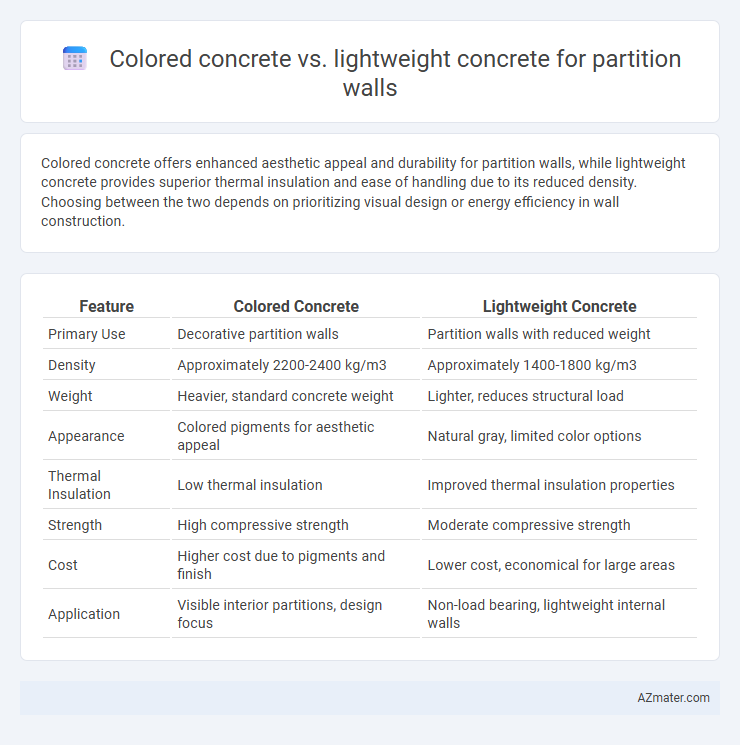Colored concrete offers enhanced aesthetic appeal and durability for partition walls, while lightweight concrete provides superior thermal insulation and ease of handling due to its reduced density. Choosing between the two depends on prioritizing visual design or energy efficiency in wall construction.
Table of Comparison
| Feature | Colored Concrete | Lightweight Concrete |
|---|---|---|
| Primary Use | Decorative partition walls | Partition walls with reduced weight |
| Density | Approximately 2200-2400 kg/m3 | Approximately 1400-1800 kg/m3 |
| Weight | Heavier, standard concrete weight | Lighter, reduces structural load |
| Appearance | Colored pigments for aesthetic appeal | Natural gray, limited color options |
| Thermal Insulation | Low thermal insulation | Improved thermal insulation properties |
| Strength | High compressive strength | Moderate compressive strength |
| Cost | Higher cost due to pigments and finish | Lower cost, economical for large areas |
| Application | Visible interior partitions, design focus | Non-load bearing, lightweight internal walls |
Introduction to Concrete Partition Walls
Concrete partition walls provide durable, fire-resistant, and sound-insulating solutions ideal for interior space division. Colored concrete enhances aesthetic appeal with customizable hues while maintaining strength, whereas lightweight concrete offers reduced weight and improved thermal insulation, facilitating easier installation and load management. Selection depends on balancing visual design priorities against structural and insulation requirements in partition wall applications.
Overview of Colored Concrete
Colored concrete offers vibrant aesthetic options for partition walls by integrating pigments directly into the mix, ensuring consistent color throughout the material. Its durability and resistance to fading make it ideal for both interior and exterior applications, providing long-lasting visual appeal. Unlike lightweight concrete, which prioritizes insulation and weight reduction, colored concrete focuses on enhancing design flexibility without compromising structural integrity.
Overview of Lightweight Concrete
Lightweight concrete is composed of lightweight aggregates such as expanded clay, shale, or perlite, making it significantly lighter than traditional concrete while maintaining adequate strength for partition walls. It offers improved thermal insulation, reduced dead load on structures, and enhanced fire resistance, making it ideal for interior partition applications. Compared to colored concrete, lightweight concrete provides superior ease of handling and energy efficiency, though it may have a rougher finish and limited color options.
Key Material Properties Comparison
Colored concrete offers high compressive strength and excellent durability, making it ideal for aesthetic and structural partition walls with vibrant finishes. Lightweight concrete, known for its reduced density and superior thermal insulation, provides easier handling and energy efficiency but typically has lower compressive strength compared to colored concrete. The choice between these materials hinges on prioritizing strength and color customization versus weight reduction and insulation performance in partition wall applications.
Aesthetic Flexibility: Colored Concrete Benefits
Colored concrete offers superior aesthetic flexibility for partition walls by allowing a wide range of hues and finishes that enhance interior design without the need for additional decorative treatments. Its integral pigmentation ensures consistent color throughout the material, reducing maintenance and wear over time compared to painted or surface-applied systems. This reliable color retention and customization capability make colored concrete an optimal choice for visually impactful and durable partition solutions.
Structural Performance: Lightweight Concrete Advantages
Lightweight concrete offers superior structural performance for partition walls due to its reduced density, which decreases the overall load on the building foundation and supporting structures. This material provides enhanced thermal insulation and energy efficiency compared to colored concrete, improving indoor comfort and reducing energy expenses. Lightweight concrete also exhibits excellent fire resistance and sound absorption properties, making it a practical choice for partition walls in residential and commercial buildings.
Installation Methods and Ease of Use
Colored concrete for partition walls requires precise mixing and finishing techniques to maintain pigment consistency and achieve a smooth, visually appealing surface, which can extend installation time. Lightweight concrete offers easier handling and faster installation due to its reduced weight and improved workability, making it ideal for quick partition wall setup. Both materials demand specific methods but lightweight concrete is generally favored for ease of use and speed on site.
Cost Considerations and Long-term Value
Colored concrete for partition walls typically incurs higher initial costs due to pigment additives and specialized finishing processes, but offers superior aesthetic appeal and durability that can enhance property value over time. Lightweight concrete, with its lower density and reduced material usage, often provides cost savings in transportation and labor, while improving thermal insulation and reducing structural load, contributing to long-term energy efficiency. Evaluating cost considerations against factors like maintenance, lifespan, and energy savings is crucial to determining the optimal choice for partition wall applications.
Durability, Maintenance, and Lifespan
Colored concrete offers superior durability with high resistance to weathering and minimal surface wear, requiring low maintenance due to its integral pigmentation that reduces the need for repainting. Lightweight concrete, while easier to handle and install due to its reduced density, generally has lower compressive strength and may require more frequent maintenance to address surface cracks or wear. The lifespan of colored concrete partitions typically extends beyond 50 years with proper care, whereas lightweight concrete partitions may have a shorter effective lifespan, especially in high-stress environments.
Choosing the Right Concrete Type for Partition Walls
Choosing the right concrete type for partition walls depends on factors such as weight, strength, and aesthetic appeal. Colored concrete offers vibrant finishes and durability suitable for decorative partitions, while lightweight concrete provides excellent thermal insulation and reduces structural load, ideal for non-load-bearing walls. Evaluating project requirements and performance criteria ensures optimal selection between colored and lightweight concrete for partition wall applications.

Infographic: Colored concrete vs Lightweight concrete for Partition wall
 azmater.com
azmater.com